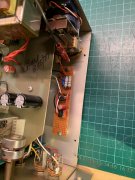I should have mentioned that as built C10 was a 100uF capacitor, not 470uF as shown on the schematic. This gave a timing of about 9 seconds. I changed it to 220uF to extend the time.
You're right, but just. Tests that I conducted this morning, the DC transient was essentially over in a little more than 2 seconds and the DCP did not trigger. To do this test I disabled the timing circuit by shorting the emitter and collector of Q5 which causes Q6 to saturate pretty much when B1 comes on.
The transient causes the needles on the meters to slam full max for a moment and then relax just before I hear the DCP relay click on. They slam again at turn off, but after the DCP has disconnected the speakers.
Don & jbeckva - Thanks for the timing info. I don't see the need to go beyond 10 seconds or so.
Here's my current plan:
- I've ordered the Brown Dog adapter to replace the RC4136 with two OPA2134s. The hope is this will reduce that initial transient, but even if it doesn't, the OPA2134 is a better op amp and better is the enemy of good enough.
- Either shorten or disable the PL4000 timing circuit. I don't see the need for it. Transient exists either way. I just want the transient over before the DCP energizes.
- Extend the DCP to about 6 to 10 seconds. That's more than sufficient.
- Plug the PL400 into a power strip and plug that power strip into the switched outlet of the PL4000. Normal operation would be to have the power switch open (PL400 off), turn on the PL4000, count to 5 potatoes, and then turn on the power strip (turning on the PL400). This would prevent all the needle banging, but if I forgot to turn off the power strip, everything would come up alright in the end. This kind of sucks, but the alternative would be to leave the PL4000 on all the time - just like Dynaco did with the PAT5 to prevent the same issue.


